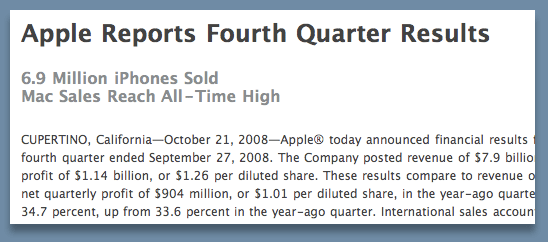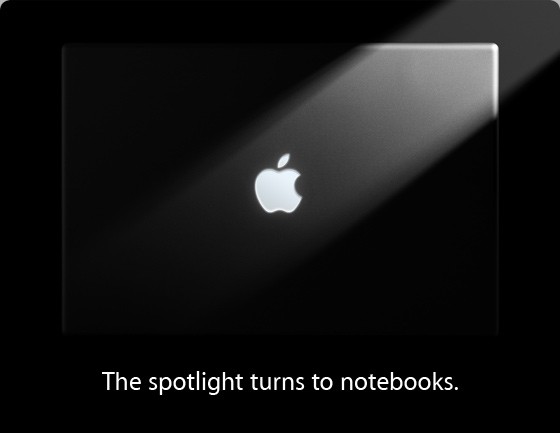Apple’s latest financial results call was an interesting one on several fronts. Indeed, I think it may be looked upon years from now as a milestone in the company’s history.
Why? Mainly, because it marks a clear point in time where the company stopped being a computer company and started being a consumer device maker. As Steve Jobs pointed out in a recent keynote, Apple is a company that stands on a three-legged stool. Macs — computers — are obviously one leg; iPods a re the second; and now, iPhones make up the third leg of that stool. The analogy is an apt one. Apple’s not a computer company that makes iPods and iPhones as a side business: the three-legs more or less equally support the company. As Apple reported, iPhones made up 39% of Apple’s business (using the non-GAAP figures — we’ll get into that in a minute.) That’s an astonishing statistic. In just 15 months, the iPhone has become the biggest single contributor to Apple’s bottom line, with lots of room to grow. iPods account for 31% and Macs themselves make up the smallest portion of revenue at 30%.
re the second; and now, iPhones make up the third leg of that stool. The analogy is an apt one. Apple’s not a computer company that makes iPods and iPhones as a side business: the three-legs more or less equally support the company. As Apple reported, iPhones made up 39% of Apple’s business (using the non-GAAP figures — we’ll get into that in a minute.) That’s an astonishing statistic. In just 15 months, the iPhone has become the biggest single contributor to Apple’s bottom line, with lots of room to grow. iPods account for 31% and Macs themselves make up the smallest portion of revenue at 30%.
A brief word on GAAP
A lot of Apple-watchers are getting a quick lesson in economics over the company’s decision to use GAAP (Generally Accepted Accounting Principles) and book the revenue generated from its iPhones (and Apple TV’s) using a subscription method. That means that rather than booking the entire revenue generated from a sale in the period in which the sale was made, Apple spreads out the value of the sale over 24 months. In its interpretation of the rules, Apple believes that method allows it to provide free software updates over the course of those two years, rather than having to set a value for them. That’s why iPod touch owners have to pay for the updates that iPhone owners get for free. The company doesn’t make more of less money using either method; it just gets counted differently. So, if the revenue generated by iPhone and Apple TV sales did not have to get spread over two years, Apple’s results would be even higher. That’s why the company also reported what its results would be under non-GAAP accounting. As Jobs said in the call, the iPhone story was “too big for Apple management or investors to ignore.”
So, adjusting for non-GAAP reporting, take a look at Apple’s performance in the fourth quarter over the past three years.
Fourth Quarter Revenue (non-GAAP)
- 2006: $4.84 billion
- 2007: $6.22 billion
- 2008: $11.68 billion
The growth is stunning and illustrates a truly transformation period in the company’s history.
Wither the Mac?
I think this is wonderful news for that first leg of the stool, the Macintosh. It gives Apple a lot more breathing room than if it remained primarily a computer company. The diversity brought by the iPod and iPhone is insulating. It means Apple does not have to have a huge hit with every computer product. It means it has the luxury of being innovative, of spending money on R&D (Forget not, either, that the company has no debt and cash on hand of $25 billion — an increase of almost $10 billion since just last year.) And let’s not forget that much of the innovation on the other two legs of the stool begins or is to some extent reliant on what Apple does to the Mac. It’s a symbiotic product mix that I think Apple views in a holistic way, so I don’t see the Mac going away any time soon.
A few other notes
Steve Jobs couldn’t resist delivering the news in person that Apple outsold BlackBerry maker RIM in this quarter, and that by revenue, Apple is now the third-largest mobile phone seller in the world — again, in just 15 months in the market.
Rumor mongers will point to the fact that Jobs was on the call as some sort of sign regarding his health. The truth is that Steve does occasionally take part in these calls — though not often. I think he was there primarily to crow about the success of the iPhone and the fact that the 10 million unit goal for 2008 was reached two months early; and to talk to analysts about the uncertainty of the economy over the next period and its potential impact on Apple.
I’ll be on a MacJury podcast panel later this week to talk more about the conference call and other Apple matters. Visit the MacJury webpage or check back here for a link when the show is posted.

